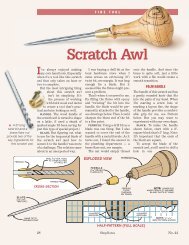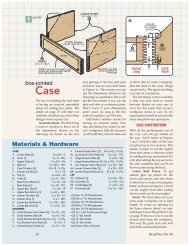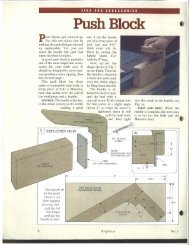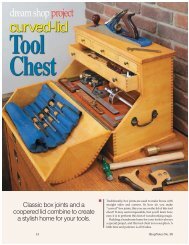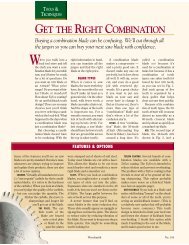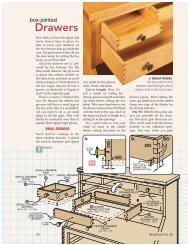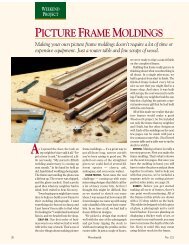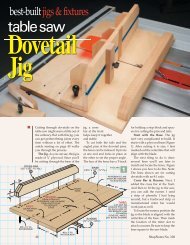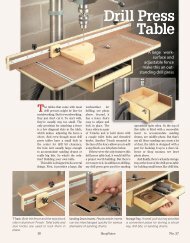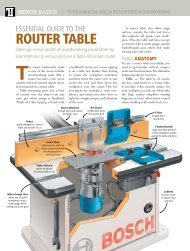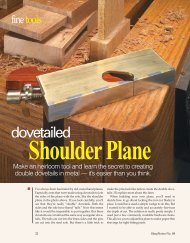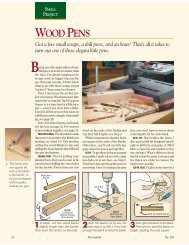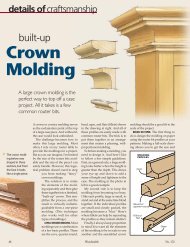Routing a Perfect Tenon - Woodsmith Woodworking Seminars
Routing a Perfect Tenon - Woodsmith Woodworking Seminars
Routing a Perfect Tenon - Woodsmith Woodworking Seminars
Create successful ePaper yourself
Turn your PDF publications into a flip-book with our unique Google optimized e-Paper software.
TOP VIEW<br />
SMALL BITES<br />
WITH THE GRAIN<br />
REDUCES STRESS<br />
ON ROUTER<br />
ROUTER<br />
BASE<br />
A <strong>Perfect</strong> <strong>Tenon</strong>:<br />
Step-by-Step<br />
WORKPIECE<br />
FENCE<br />
STOP<br />
SIDE<br />
SIDE VIEW<br />
(CROSS SECTION)<br />
WORKPIECE<br />
FENCE STOPS<br />
ROUTER BIT<br />
AT SHOULDER<br />
SPIRAL DOWNCUT<br />
BIT REDUCES<br />
TEAROUT<br />
STOP<br />
{ Secure Clamping. After clamping the workpiece<br />
to the workbench, securely clamp the jig<br />
to the workpiece to keep it in position.<br />
see it’s just a fence, stop, and two<br />
sides made from 3 ⁄ 4 " plywood. The<br />
jig is assembled to fit snug around<br />
the workpiece to make routing the<br />
tenon more accurate.<br />
Sizing the Jig. There are several<br />
things to keep in mind as you size<br />
the jig. Of course, the length of the<br />
tenon is key. But the size of the<br />
baseplate on your router and the<br />
size of the router bit you’re using<br />
are also factors. And speaking of<br />
the bit, I use a 1 ⁄ 2 " spiral downcut<br />
bit. It cuts clean shoulders on the<br />
tenon without tearout.<br />
Fence. To locate the fence, measure<br />
the distance from the outside<br />
edge of the router bit to the edge of<br />
the baseplate. Then add that measurement<br />
to the length of the tenon.<br />
This will be the distance between<br />
the fence and stop.<br />
Sides. With this measurement<br />
in mind, you can add that to the<br />
width of the fence and stop to<br />
determine the length of the sides.<br />
Stop. The stop is attached to the<br />
end of the jig so it registers against<br />
the end of the workpiece. So after<br />
gluing up the two layers, you can<br />
attach it to the sides. Finally, you<br />
can fasten the fence in place.<br />
USING THE JIG<br />
Once the jig is built, cutting the<br />
tenon is easy. The box at right<br />
helps you through the process.<br />
But before you start, clamp the<br />
workpiece securely to the bench.<br />
Then clamp the jig to the face of<br />
the workpiece, as shown in the<br />
top photo at right. Set your router<br />
against the fence of the jig and verify<br />
the inside edge of the bit lines<br />
up with the shoulder mark of the<br />
tenon before you start routing.<br />
First Cheek. You’ll start by routing<br />
one cheek of the tenon. For the<br />
best results, you’ll want to rout in<br />
several shallow passes. Each cut<br />
should be about 1 ⁄ 4 " deep. If you’re<br />
using a fixed-base router, you’ll<br />
rout all four sides of the tenon<br />
before adjusting the depth. This<br />
makes it easy to sneak up on the<br />
final size of the tenon.<br />
Shoulder Cut. With one tenon<br />
cheek routed, turn the workpiece a<br />
quarter turn to work on the shoulder.<br />
You’ll need to clamp the jig in<br />
place once again, but there’s one<br />
thing to note. In order to support<br />
the cut to minimize tearout, clamp<br />
the jig so the router bit cuts into<br />
the side of the jig at the back of the<br />
cut. You can see what I mean in the<br />
bottom photo at right.<br />
Opposite Cheek. Now you can<br />
rotate the workpiece another quarter<br />
turn to rout the opposite cheek.<br />
Finally, you can rotate the workpiece<br />
once more and cut the last<br />
shoulder to complete the tenon.<br />
This technique is surprisingly<br />
simple, and the jig is easy to build.<br />
I think you’ll find it will save time<br />
when you’re working with large<br />
workpieces in the shop.<br />
{ Rout With the Grain. To start the cut, route<br />
down one side of the tenon. Then continue<br />
removing the waste, routing with the grain.<br />
{ Shoulder Pass. Rout back and forth with<br />
the grain until you reach the fence. Then make<br />
a final pass along the fence.<br />
{ Completing the <strong>Tenon</strong>. For each additional<br />
edge, rotate the workpiece and clamp the jig in<br />
place to prevent tearout at the end of the cut.<br />
www.ShopNotes.com 35



